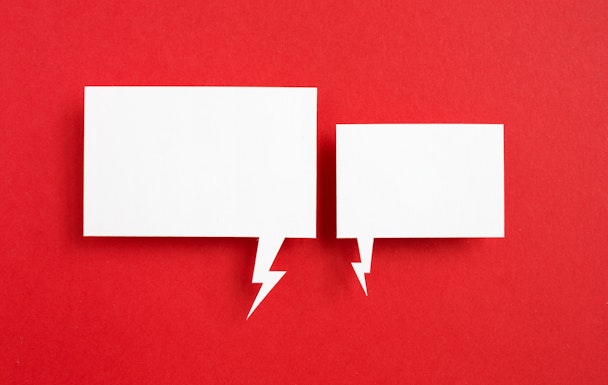The power of words: how inclusive language can make for a more equitable workplace
Whether it’s neutralizing language, disclosing pronouns or not making cultural assumptions, inclusive language can make all the difference in creating a truly equitable workplace. But how can leaders manage its implementation from the top down?

How inclusive language can make for a more equitable workplace
There is no doubt that language has the power to shape culture. And this is particularly true of the language used in the workplace.
Without the implementation of inclusive language, employers run the risk of not only ostracizing certain groups within the workplace, but of perpetuating harmful workplace environments that can continue cycles of harm and oppression for marginalized groups.
So why has the importance of inclusive language at work and in diversity and inclusion efforts been downplayed for so long? The Drum speaks to organizations and industry leaders to find out how firms can educate staff on the importance of inclusive language and encourage its implementation for the greater good.
Considering intersectionality
When speaking about the use of inclusive language, many point to gendered language, such as expressions like ‘hey guys’ or the unconscious biases revealed in the language that lead to men and women being treated differently in the workplace.
Earlier this year, Jessica Kielstra and Nina Forbes launched their study into the varying ways in which junior creatives are spoken to in the industry on the basis of gender. It revealed that friendlier and more relaxing lines of communication are consistently used towards men and less commonly towards women, leading to the potential for increased advantages due to feelings of security and confidence.
However, as Rukaya El-Turki, chair of the equals network at M&C Saatchi Group, explains: inclusive language should be more widely considered as that which avoids the use of certain expressions or words that might be considered to exclude particular groups of people, and applies to any underrepresented or marginalized groups such as ethnic minorities, people who are religious or members of the LGBTQ+ community.
“It’s really about communicating without any assumptions about your audience,” she says. “It’s about about being aware of your unconscious biases. You cannot assume that the people you work with and are talking to have the same lived experiences as you.
“For example, I’m a practicing Muslim and you can’t imagine the number of times I’ve been invited to catch up over a pint or told I deserve a glass of wine after a day of work.
“I understand the sentiment behind statements like this, but it goes back to the idea that it is dangerous to make presumptions in the workplace – whether it’s around someone’s pronouns, their culture or their lived experience.”
El-Turki points to the rise of including identifying pronouns in introductions or email signatures as a successful example of how inclusive language can make a positive difference to people’s experience in the workplace. “Two or three years ago there was less of an understanding around why pronouns are important, why we should be aware of them and the impact that getting them wrong can have on people.
“There is a valuable lesson to be learned here around intersectionality, because if you create a sense of belonging, then you’re more likely to drive better results in your staff retention and employee satisfaction, and it demonstrates to clients internal and external that you know the fundamentals of diversity in your business’s culture and have values that place people’s wellbeing at the forefront.”
She concludes that organizations have an obligation to move the conversation forward and challenge the status quo, and that can be as simple as correcting someone who uses incorrect language, because “it’s very difficult to make any sort of cultural change through policy rollout or even training if people don’t understand that, at its core, it is affecting individual people”.
Impact versus intent
Lorraine Jennings, the director of wellbeing services and culture change at ad industry support organization Nabs, echoes these sentiments. She says that using the wrong language – for example, around assuming someone’s gender – could not only offend and upset, but can in the worst cases be discriminatory.
“As well as other reasons, there could be a fear of saying something wrong. It can become paralyzing. Yet taking the smallest of actions to begin your journey on addressing this, rather than de-prioritizing it, will minimize the risk of saying something wrong.
“No one can rely on the excuse of ‘that wasn’t my intention’, because we all need to consider impact versus intent. You may not realize that you’re using potentially offensive language, but certain terms or phrases could be taken as such. Your intent may not be harmful, but the impact on the individual is. Learning how to actively listen and to genuinely apologize are necessary skills.”
Jennings explains that education is the key to understanding why inclusive language is so important, highlighting that this requires a level of self-education as well as workplace education, training and policy.
“Organizations need to support their teams with training – there are many quality training providers out there – but on an individual level, people also need to take responsibility as part of their self-education journey.
“At Nabs, we encourage our team members to take time from their working week for self-education on matters relating to diversity, equity and inclusion, and our particular focus at the moment is on anti-racism and particularly anti-Black racism. We’ll often share resources with each other as a way of supporting each other’s learning and we hold bi-monthly team group sessions for learning reflections.”
Words matter
Jennings also points to specialist organizations, such as diversity and inclusion educators The Other Box, which is working towards educating businesses on their unconscious biases. Roshni Goyate, its co-founder, explains to The Drum that “toxic language, full of microaggressions and with no one speaking up against it, leads to toxic, unsafe workplace cultures – particularly for those who are from more marginalized backgrounds and have to face everyday erasure, misrepresentation, stereotypes and bias“.
The Other Box runs a course titled The Diversity Dictionary, which educates leaders on what microaggressions are and why it’s important to speak up against them, and offers advice on how to speak up.
Goyate explains: “We teach the meanings of words, but more importantly we educate on the need to approach inclusive language with a growth mindset. By this I mean that we all need to be open to the idea that language is constantly evolving, and what may have been widely used and acceptable once upon a time may no longer be acceptable today.
“We can all engage in critical thinking and self-awareness to make the simple switch from non-inclusive to inclusive whenever it comes up.”
The increased consideration of inclusive language in the workplace has led to software developments such as Textio, an augmented writing platform that offers language insights in company communications such as job descriptions and reviews them for excluding qualities such as gendered language.
Currently being trialed by AKQA, the WPP agency’s managing partner Sam Kelly tells The Drum: “The best work is created by diverse minds and new technologies allow us to analyze our current language to ensure it’s inclusive and that it attracts the best candidates.”
But when it comes to encouraging the widespread use of inclusive language in the workplace, The Other Box’s Goyate concludes that as with any kind of cultural and behavioral change, it takes a consistent, multi-pronged approach. It needs education, policy, positive affirmation and regular check-ins.
“Organizations also have to show vulnerability in admitting when they get it wrong – because we all get it wrong – and demonstrate the ability to learn from mistakes. Leadership and management teams need to be in open dialogue with the entire organization, be open to feedback and open to course-correcting when they do get it wrong.”
While most people would say they are not overtly sexist, racist, homophobic or ableist, we are all capable of slipping into oppressive language and behaviors that exist in the society we have grown up in.
As Goyate concludes: “That doesn’t make it OK, but I think many people are beginning to acknowledge that something needs to be done to shift our habits and perceptions so that we can really begin to embody inclusivity rather than think of it as an abstract concept.”
Creating an inclusive and equitable work environment is the first step towards increasing and retaining diversity in the workforce. Language and communication is one of the easiest and most obvious ways to enhance such environments, and companies have an obligation to begin the process of education sooner rather than later.

